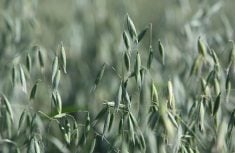Red smudge downgrades
Red smudge is one of the most common kernel diseases of wheat in western Canada. Even at low levels, this disease causes downgrading and reduces crop value.
Reddish-pink discoloration affecting more than one percent of kernels for Canada Western red spring and Canada Prairie Spring, and more than 0.25 percent for Canada Western amber durum, will cause a drop in grade from No. l to No. 2. Because of the economic impact, it is important to know that some cultivars are less susceptible to red smudge than others.
Read Also

VIDEO: Green Lightning and Nytro Ag win sustainability innovation award
Nytro Ag Corp and Green Lightning recieved an innovation award at Ag in Motion 2025 for the Green Lightning Nitrogen Machine, which converts atmospheric nitrogen into a plant-usable form.
All wheat cultivars registered for use in Western Canada are susceptible to red smudge. However, there are differences in susceptibility among cultivars, between and within classes of wheat.
A recent Agriculture Canada study done at the Semiarid Prairie Agricultural Research Centre in Swift Current has shown that red smudge develops to a greater extent in durum and some of the CPS cultivars than in most of the CWRS cultivars.
Among the more resistant cultivars grown in southwestern Saskatchewan are the red CPS varieties AC Taber and Biggar, and the CWRS cultivars Laura, CDC Makwa, CDC Merlin, AC Cora, Lancer and Roblin.
Red smudge is caused by the same fungus that causes tan spot. Tan spot on wheat has been an increasing concern on the Prairies, mainly due to the adoption of conservation tillage practices. The higher the severity of tan spot lesions on the leaves, the more inoculum there is for infection of kernels. This disease develops well in wet summers.
Because of the potential economic losses due to red smudge on wheat kernels, efforts at the research centre are now focused on introducing genetic resistance to this disease to new cultivars.
More information on the susceptibility of wheat cultivars to kernel diseases is available from M.R. Fernandez, SPARC, Box 1030, Swift Current, Sask. S9H 3X2, tel. 306-778-7200.
– Agriculture Canada
Nutrients to fight disease
Potassium and chloride nutrients help plants fight disease. Muriate of potash or potassium chloride fertilizers are the most common source of potassium.
Both potassium and chloride are involved in the opening and closing of leaf pores, controlling water flow in the plant and improving drought resistance.
By helping plant cells stay rigid, nutrients increase the strength of plant tissues, preventing breaks and tears that are entry points for disease. Plants stressed by potassium deficiency accumulate more soluble nitrogen compounds and sugars, increasing their attractiveness to pathogens.
Since chloride is negatively charged, like the nitrate form of nitrogen, the two compete for uptake by the plant. Higher levels of chloride increase the proportion of nitrogen taken up in the ammonium form, a factor linked to suppressing take-all disease in wheat.
Chloride also increases availability of manganese in the soil. Plants need about 100 times more manganese than do bacteria and fungi. Deficient plants are more susceptible to disease.
At least 16 different diseases on nine different crops – wheat, barley, corn, millet, potatoes and celery – have been shown to be suppressed by chloride. Those diseases include root rots, stalk rot, leaf rusts, mildews and septoria.
– Potash & Phosphate Institute
















